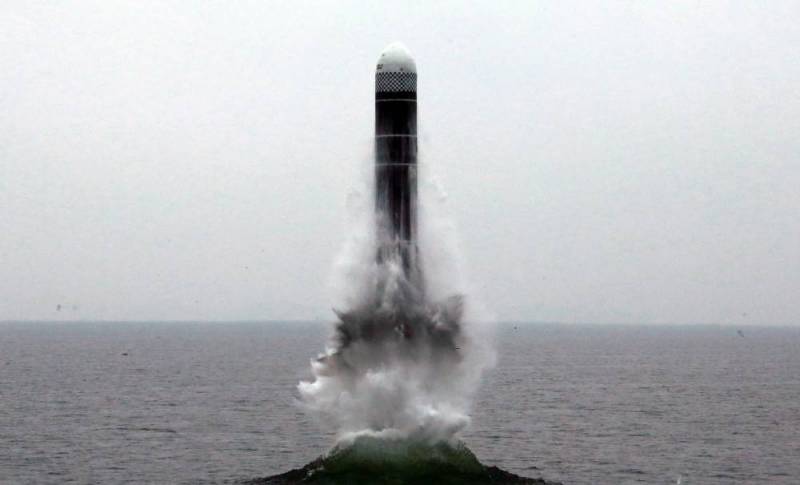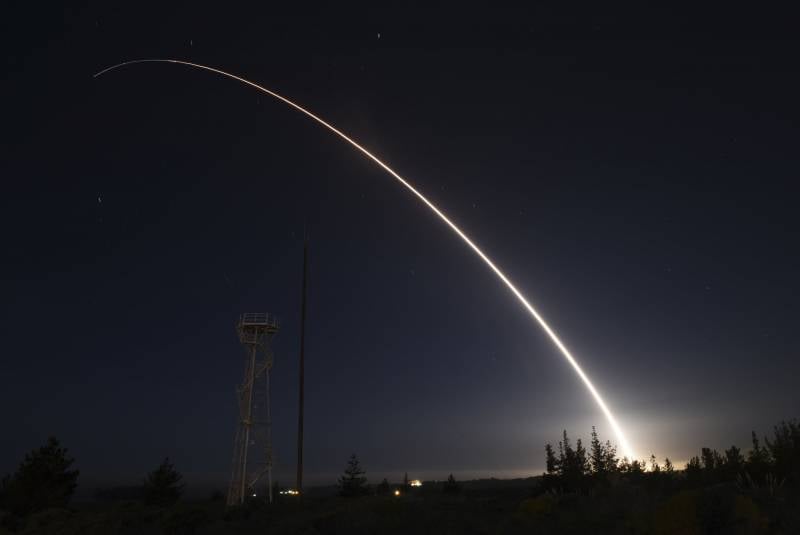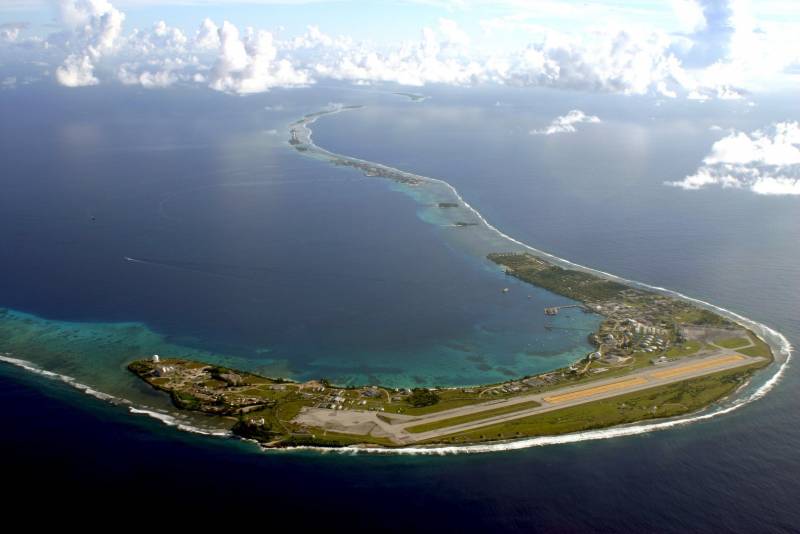USA and DPRK. Missile launch before negotiations?
In the old days, this would have been a scandalous event, and just a few years ago, any North Korean missile launch caused a storm of indignation, condemnation, up to the urgent convening of the UN Security Council and the adoption of various resolutions. Now, the matter was limited to sluggish and on-duty protests from South Korea and Japan, which were no longer paid attention to (yes, we know that it threatens security), and negotiations began a couple of days later.
Now a little conspiracy theories. Quite by chance (and on another topic) it turned out that these strange negotiations were preceded by another launch, this time an American one. 2 October 2019 from the Vanderberg air base in California, a test launch of the LGM-30G Minuteman-III ballistic missile was carried out. A rocket flew over the entire Pacific Ocean at a distance of 6760 km and hit a target in the area of the Kwajalein Atoll of the Marshall Islands in the western Pacific Ocean.
The US Air Force Strike Command emphasized that this launch did not threaten anyone and was carried out to confirm the combat readiness of ballistic missiles.
Of course, there is a certain amount of truth in this statement. The LGM-30G Minuteman-III is the backbone of American nuclear forces on constant alert. 450 rockets stand in the mines, ready for immediate launch. For this reason, the rocket is constantly being upgraded, various systems are being replaced in it, after which test launches are carried out. By 2009, rocket fuel was replaced in all missiles. They also replaced the warhead of the Mk.21A with three nuclear charges W-78 with a power of 340 kilotons to the warhead of the Mk.21 with one charge W-87 with a power of 300 kilotons (according to other sources, 457 kilotons). A new guidance system has appeared in the new warhead and a missile defense breakout system has been installed. In addition, electronic ballistic missile systems are constantly being improved and tests are being conducted to test them. They can be carried out without a nuclear explosion. This year is the third launch. The first two launches were made on 1 and 10 on May 2019. Apparently, the next stage of the modernization of the warhead is being carried out. In any case, there were reports that the accuracy of the hit was checked for testing in May 2019.
At first glance, everything seems to be usual, everything is as always. The planned test launch, the air base with which they are usually carried out, and the atoll, where warheads usually fall. Place with history, a lot of tests were conducted on this atoll, including nuclear ones, and about fifty miles to the north-west is the famous Bikini Atoll, where the first naval test of a nuclear bomb took place.
But something in this test run is wrong; for some reason, the Americans staged a test on the eve of important negotiations with the DPRK, and the rocket flew on the same day as the North Korean one.
Or, more precisely, with a difference of only 10 hours. This is not so easy to find out, because the DPRK and the United States are not only in different time zones, but also separated by an international line of date changes, but time comparison services allow you to do this. The North Korean launch took place at 07: 11 on October 2 (in California at that moment it was 15: 11 on October 1). The American launch took place in 01: 13 on October 2, that is, after 10 hours 2 minutes after North Korean.
Such a small time difference is difficult to explain by coincidence. In the end, the test launch could either be done earlier, or carried out after negotiations. A delay of one and a half or two weeks does not solve much. It was also unlikely to be a reaction to the North Korean launch. Preparation of a test run takes quite a lot of time for planning, drafting papers, preparing equipment and a training ground. It takes time to bring and load a rocket into the mine (ballistic missiles are not based on the Vanderberg base), test it, and so on. In general, all this takes more time than ten hours.
So the version remains that it was an agreement of the parties: before starting negotiations, carry out test launches to make sure that no one is bluffing.
This thought may seem strange, and it needs to be commented on. In our view, the United States has a working rocket weapons there is a self-evident thing. Largely because decades have been and are being reconnoitered, missile launches and their trajectories (giving information about their capabilities) are recorded by radars, and there was also bilateral control in the framework of agreements on limiting offensive weapons. Thus, in Russia there was always the opportunity to see American missiles on their radars, take pictures of them from satellites, and even sometimes touch them with their hands. Therefore, we have no doubt.
Not so in the DPRK. All information about American missile weapons was obtained from second or even third hands, that is, from sources that do not inspire full confidence. In addition, American weapons are praised in the media, which is why a glimpse of propaganda falls on all the information. Therefore, the North Korean leadership could well have thought that the Americans were bluffing: their Cold War rocket arsenal had decayed in the mines long ago, it couldn’t take off, and all American threats were bluffed, strengthened by their media. This is an important factor. If the Americans are bluffing, then in negotiations with them you can make a big mistake.
Since serious negotiations were being prepared on serious things, the North Korean side wanted to make sure personally that the United States has an ICBM. Then the Americans set the condition: then you show that you have, for the same reasons. So, apparently, they agreed that there would be two launches on the same date, with some time lag, so that the American launch would be on the same date. This apparently mattered to the negotiation protocol.
It was not difficult for the Americans to track the launch and trajectory of the North Korean missile, since they have radars in Japan. To control the American launch, the DPRK apparently sent a ship with a radar on board to the Kwajalein atoll area, which could collect data on the trajectory, speed, and coordinates of the fall of the American test warhead. This is an old method. Radar monitoring of American test sites in the Pacific has been carried out by Soviet ships since the 1950's. The observation of an object falling along a ballistic trajectory in the area indicated by the Americans was evidence of the presence of a ballistic missile in the United States.
Now about the essence of the negotiations. In my opinion, they were very serious and their main content was not at all the denuclearization of the DPRK, but another, more interesting thing - the neutrality of the DPRK. For the United States, the DPRK neutrality is of great importance in the context of the military confrontation with China. First, it makes impossible a sudden attack on South Korea, which will change the course of the war in favor of China. Secondly, the neutral DPRK, which became the object of some aggressive actions by China during the war, almost automatically falls into the arms of the United States. This is a sharp improvement in strategic positions, obtained without spending military resources. For the DPRK, this is also very important, since it is a matter of survival and a matter of further economic development. Neutrality, if recognized, opens many doors and opportunities.
But how will it be established, on what conditions, what concessions and actions will both parties have to make? All this is the subject of the most fierce and stubborn bargaining. I think that the interruption of the negotiations that took place not only not forever, but will soon end. The parties can converge and disagree more than once, but the importance of the issue is so great that it pushes them to continue negotiations.



Information